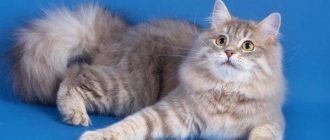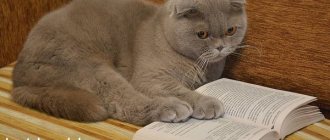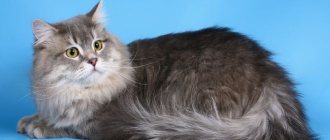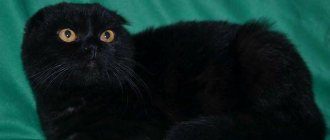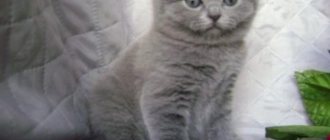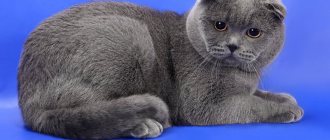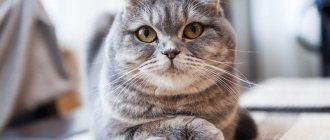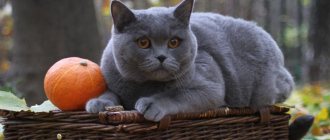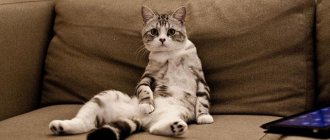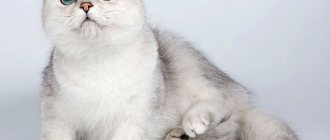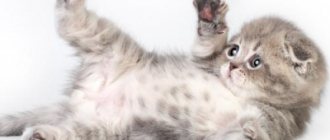Outwardly, this animal looks like a fluffy owl. The large round eyes and folded ears of a cat called Highland Ford are a distinctive feature of the breed. What representatives of Scottish Folds love, the secrets of breeding and maintaining the health of their pets: felinologists became interested in their furry charges even before the official recognition of the breed standard.
Origin story
Presumably, the “Persians” owe their long hair, since representatives of the Persian breed participated in selection with the British. The first matings were carried out in the 60s. XX century.
At first, fold-eared kittens were considered a waste, but every year such a marriage appeared more and more often, so in 1986 the first small Highland with folded ears was shown on television in America.
After this, the Highland Fold breed began to be taken seriously and soon the first representatives of the Fold began to appear at exhibitions. But official recognition dates back only to 1993.
Today, finding Highlands is problematic, because they are quite rare, unlike the eared short-haired brothers of the Scottish Fold.
In Russia there are special nurseries where only this breed is bred. But the Folds never managed to gain recognition - many exhibitions do not consider these cats as a breed, or reject participation due to their non-standard color.
Vaccinations and antiparasitic treatment
Highland Folds are not immune to contracting deadly infectious diseases. Scottish Fold cats must be vaccinated annually:
- from rabies;
- calcivirosis;
- panleukopenia;
- chlamydia.
The first vaccination at the age of 12 weeks is carried out in the nursery. It is important to make sure that the kitten has been vaccinated against all of the diseases listed. The breeder must give the new owner a veterinary passport, which contains information about vaccination.
Even if the Scottish Fold cat does not go outside, it is necessary to periodically treat fleas using drops on the withers. It is recommended to worm your Highland Fold twice a year.
Description of the breed
Highland Folds have almost the same standards as Scottish Folds, differing from them only in ears and coat. At exhibitions, this breed is presented as one of the varieties of Scottish Fold Longhair cats.
| Body | Small, round and flexible. Animals have developed muscles and a wide chest. In size, cats are slightly larger than cats. |
| Wool | Thick, fluffy and short. Feature – the “collar” and “pants” stand out very well. The wool itself is silky and soft. Rare colors - solid black and white animals. The most common folds are smoky, tortoiseshell, as well as spotted tabbies and harlequins. |
| Head | A wide head is proportional to the body according to standards. |
| Eyes | Widely spaced, round, mostly yellow in color. |
| Ears | Small, pressed against the head, with rounded ends. Folded in half, directed towards the middle of the muzzle. It is the ears that distinguish them from other breeds. |
| Limbs | The legs are short but powerful. The front ones have five toes, the rear ones have four. The tail is thick, bends easily, long, measuring at least 2/3 of the length of the body; with a smaller tail size, cats are considered defective. |
Colors
In addition to the silky structure of its thick and long coat, the Highland Fold has a stunningly wide palette of colors. Conventionally, they are divided into the following groups:
- Plain. All existing options are marble, black, chocolate, blue, lilac and red. The color is solid, without marks, spots or stripes.
- Smoky. In this case, the undercoat is colored entirely light, and the tips of the guard hairs are black.
- Bicolor. The Highland Fold of this color has a variety of combinations of strictly two colors in the form of spots and markings.
- Colorpoint. The breed standard allows for acromelanism in Highland Folds. In this case, the body is painted in a light color, and the protruding parts of the body: muzzle, legs, tail, and sometimes ears are dark.
- Tabby. In this case, the cat will look like a tiger or leopard, only in a more fluffy and touching version. Any combination of colors, the main thing is a clearly readable letter “M” on the forehead.
- Tortoiseshell. Basic colors are black and red in a bizarre combination.
- Calico. Considered one of the rare ones: the lower part of the Highland Fold's body is painted white, and the upper part has different shaped spots of black and red.
Health
Highland Fold cats rarely get sick. The most common diseases:
- One of the main pathologies that is specific to folds is osteochondrodysplasia. It cannot be cured. It appears when the animal was mated incorrectly. As a result, the cat begins to limp, it cannot jump, as a result, the limbs become deformed, and development slows down. When contacting veterinarians, the pet is prescribed special medications that alleviate the condition and prevent the development of an incurable disease.
- Another disease that is typical of Highland Folds is urolithiasis. It appears mostly in males, especially in those who have already been castrated. If you notice that your cat is experiencing pain when urinating, he is bleeding, and he is constantly licking his genitals, then immediately show him to the veterinarian. If you apply a warm heating pad to the animal's belly, you can slightly reduce the pain and cramps.
- Heart pathologies also occur in this breed of cats. This manifests itself in symptoms such as shortness of breath, difficulty breathing, and irregular heart rhythm. For cardiomyopathy, it is necessary to follow appropriate therapy and monitor diet and lifestyle.
- Another problem with Scottish breeds is obesity. Therefore, pay attention to ensure that your pet eats properly and does not overeat. This way you can prevent this disease.
- Many Highland owners know firsthand about inflammation in the ears and eyes of their pets. If a problem is detected in time, it can be eliminated very quickly.
It is also worth paying attention to timely vaccinations and taking antihelminthic medications.
Character
All Highlands are very pliable and have a calm character. They are friendly towards all family members and absolutely non-aggressive.
They are very attached to the house and to the owner, they love care and attention to their person. But they won’t impose themselves either. They easily accept other pets and get along well with children, although there is a lot of talk about their touchiness and jealousy.
They don’t hide in front of guests, don’t run away, easily allow themselves to be petted and love to show off. The characteristic features of folds are:
- good learning ability;
- curiosity;
- understanding;
- calm;
- good nature;
- sociability.
Possible problems
Scottish Fold Highland Fold cats very rarely create problems for their owners. But sometimes this happens.
- If anyone in the family has allergies, you should not get this breed, because long hair will cause nightmares, and your beloved pet will have to be placed with another family.
- Fold long-haired cats of the Scottish breed are very jealous by nature, so if the owners have several pets at once, then they will have to pay equal attention, or show more love to the jealous fold cat.
- They require increased attention, so they do not like to be left alone for a long time. If your job does not allow you to spend a lot of time at home, then it is better not to start a fold.
- These cats are real creeps. The temperature of the room where they live should not be less than 18–20 degrees. At lower temperatures, they easily catch cold and freeze, although they have thick fur.
How to feed?
It is recommended to select food for animals from the holistic class, since these foods contain natural ingredients.
The fold-eared long-haired cat is not fussy about food. Among industrial feeds, veterinarians recommend the holistic class. Despite the high cost of the product, such food contains all the necessary and natural ingredients. There are medicinal lines and types for removing hair from the stomach. The most popular are Farmina, Grandorf, Acana, Go, and Origin.
In addition to food, the Highland Fold menu should include boiled fish fillet without bones (no more than 1 meal every 1.5 weeks), rice or buckwheat porridge, liver (1 meal every 1-2 weeks), a hard-boiled egg, boiled vegetables - potatoes, carrots, beets, as well as lean meat and cottage cheese. Veterinarians categorically do not recommend bones, fatty and fried foods, salty, sweet, smoked, tomatoes, avocados, broccoli, peas or beans.
Care
Caring for Highlands does not require any specific skills. Even if this is your first pet, you should know that caring for it will be very easy.
Wool
Highland Fold cats have very pliable and soft fur that does not mat or mat, although it is considered long.
To prevent pieces of fur from accumulating in the stomach, it is necessary to comb your pet at least twice every seven days. When shedding occurs, this process should be done more often.
To keep the fur clean, these cats need to be bathed periodically. But remember, they do not tolerate water, so there is no need to do this too often. A sufficient frequency in this case is once every 6 months using cat shampoo. The water should not exceed a temperature of 40–44 degrees.
Nutrition
There is no need to follow any diets for this breed, but there is a need to pay attention to the frequency of feeding, as overeating can have a detrimental effect on your pet’s health.
- The volume of daily feed should not exceed 250 g. 80% of the diet should be meat such as poultry, rabbit or beef.
- You can also boil Highland offal, but not more than 2 times every 7 days.
- Sometimes you can feed your pet boiled yolk and fermented milk products.
- These cats love well-boiled porridge, so don’t deny them this pleasure.
- You can also boil the plants and, to ensure that the cat does not refuse this food, mix it with pieces of meat.
- Plant special grass from the pet store on the windowsill. It will help your cat get rid of hairballs in her stomach.
Never buy or feed your Highlands the following foods:
- potatoes;
- milk from the cow;
- bread;
- sweets;
- mushrooms;
- legumes;
- seasoned and canned foods;
- fried foods.
When choosing ready-made food, you should give preference to premium products. Giving food from the table is strictly prohibited.
Up to six months, feeding is carried out 5 times a day, before a year it is reduced to three times, after a year - to two. Also, the cat should always have fresh water in its bowl.
Walk
This domestic breed does not need to be walked. She feels great at home. A city apartment is the perfect place for a Highlander. If you live in a private house, then you shouldn’t worry either. Curious pets will have no problem walking in the yard or sleeping on the windowsill with the window open.
Catering
The attractiveness of Highland Folds directly depends on what they eat. If the food is unbalanced, poor in vitamins and microelements, and does not contain enough proteins, fats and other important components, the luxurious beauty will quickly turn into an exhausted creature, with dull and sparse hair, a dull look and a bunch of health problems.
Breeders are recommended to feed these cats natural food. The reason is not only the “capricious” stomach, but the fact that the owner will be able to independently control the quality of the products.
Natural products
A natural menu should include:
- Meat. It is an essential source of proteins, taurine and amino acids. The meat is first cut into small pieces (1-2 cm), fat and skin are removed, frozen for 2-3 days (to destroy parasites and their eggs), and before feeding, scald with boiling water and cool. Highland Folds are allowed to eat chicken, beef, turkey, horse meat, veal, rabbit and lamb meat, as well as offal (liver, heart, ventricles). Chicken necks and cartilage are ground, but minced meat should not be given: if the load on the teeth is lost, they will collapse over time).
- Fish. Contains vitamins D, A, B1, B2, omega 3 and omega 6, minerals, but there is little calcium in fish. In large quantities, it destroys vitamin B1, causes iron deficiency anemia, depigmentation of the coat, and is often infected with helminths. Captive-grown fish often contain antibiotics, while river fish often contain heavy metals. Fish is not given every day, but a maximum of once a week, a small piece, preferably not separately, but mixed with porridge. The following varieties are allowed: hake, cod, flounder, sea bass, blue whiting, haddock, capelin, ruffe, tench, navaga, pollock, salmon, tuna. The fish is boiled, cleaned of bones, fins and heads. It is allowed from time to time to pamper the animal with seafood: shrimp, squid, rapana, lobsters, lobsters, mussels, crayfish.
- Vegetables. Cats are indifferent to raw food, so everything will have to be boiled or stewed. Pumpkin, zucchini, beets, cauliflower, broccoli, and spinach are allowed.
- Porridge. Rice, buckwheat, oatmeal, pearl barley, barley. They are boiled in water, meat or vegetable broth, and very little milk is added (solely for taste). They give it from a month or two. Add a drop of any vegetable oil (olive, sunflower, flaxseed) and a boiled egg yolk (or a whole quail egg) to the porridge.
- Dairy products. Hard unsalted cheese, yogurt, fermented baked milk, cottage cheese, sour cream: allowed 3-4 times a week.
Water - only clean water (not from the tap, but from a bottle, purified by filter or settling method), at a pleasant drinking temperature (not hot or icy).
The following products are prohibited:
- fresh fresh meat without treatment with water (a source of helminths);
- fried, smoked, salted, canned, dried (retains liquid, upsets the balance of minerals, upsets metabolism);
- waste: skin, feathers, heads, bones, paws (can injure the throat and stomach);
- pork and lamb (fatty), goose, duck and wild bird meat (tough, may be infected with parasites);
- pea porridge and legumes in general (indigestion and flatulence);
- products with cocoa beans (do not decompose and are not excreted from the body);
- alcohol, beer;
- tea, coffee (the cardiovascular system suffers);
- mushrooms (poisoning);
- tomatoes, potatoes, avocados, garlic, onions, sorrel, rhubarb, grapes, dried fruits, fruit seeds (damage to the gastrointestinal tract);
- sweet, salty, sour, smoked, dog food.
It is allowed to give in minimal quantities: potatoes, flour, pastries, milk (if the cat has been accustomed to it since childhood), raw cucumbers, melon, apples, watermelons, fresh corn, semolina, millet and corn porridge.
Recommended food
Below are recommended super-premium and holistic foods. Links with the names of the food are clickable, on them you can, within our website, get acquainted with the descriptions of the food and read reviews from owners of Highland Fold cats.
| Holistic | Super premium | Super premium |
| Alleva Holistic | Monge | Grandin |
Breeding
It is very difficult to find a partner for a fold-eared beauty, because this breed is not very popular. This also affects the number of nurseries, which can be counted on one hand. Uncontrolled breeding leads to the birth of kittens with diseases associated with the musculoskeletal system.
It is also worth paying attention to the fact that the Scots are ideal partners for Highland Folds. When crossing two cats of the same breed, there is a risk of giving birth to kittens with serious pathologies. Therefore, contact nurseries where all babies are guaranteed to be healthy.
Name
The Scottish longhaired cat breed - Highland Straight and Highland Fold - got its name in honor of the highland regions of Scotland, where the wild ancestors of modern longhaired Scottish cats used to live.
Modern fashion for cats has slightly pushed the long-haired breed into the shadow of its older brother, the Scots Shorthair. However, considering the appearance and temperament of these wonderful fluffies, we can say with confidence that this did not happen deservedly.
Purchasing a kitten
If you want a kitten of this particular breed, then you should first go to the nursery and observe the baby, so you can choose a Highland Fold kitten with the appropriate character and at the initial stage identify the presence of any diseases.
When purchasing, special attention should be paid to the tail. A short and motionless tail indicates problems with the joints.
A healthy kitten has clear eyes and soft, fluffy fur. The character is friendly and playful, the baby himself is active and easily makes contact. If you don’t notice anything alarming, then you can safely take the kitten home.
Highland fold price. Where to buy a Highland Fold. Nurseries
The price for small fluffy Highland Folds is quite low. On numerous websites with advertisements, such a pet can be bought for about two thousand rubles.
The offspring of exhibition animals will naturally cost more. A specialized nursery of highland fold folds can charge up to thirty thousand rubles for a kitten.
Nurseries:
- Vanaheim;
- Lemur;
Adaptation of a kitten in a new home
At the time of purchase, the kitten is three months old. His actions are conscious, so the house will initially be foreign to him. The owner must prepare for the baby's arrival:
- Buy a tray and feeding bowls.
- Let him sniff and get to know his new home.
- First, show him the toilet and the place where he will eat.
Although Fold Highlands are rare, once they appear, they forever take the love of their owners. This special breed is easy to care for, does not require elite food, gets along with children of any age and loves to lie on adults' laps. With proper care, a beloved pet will please its owners for about 20 years.
Did you like the article?
